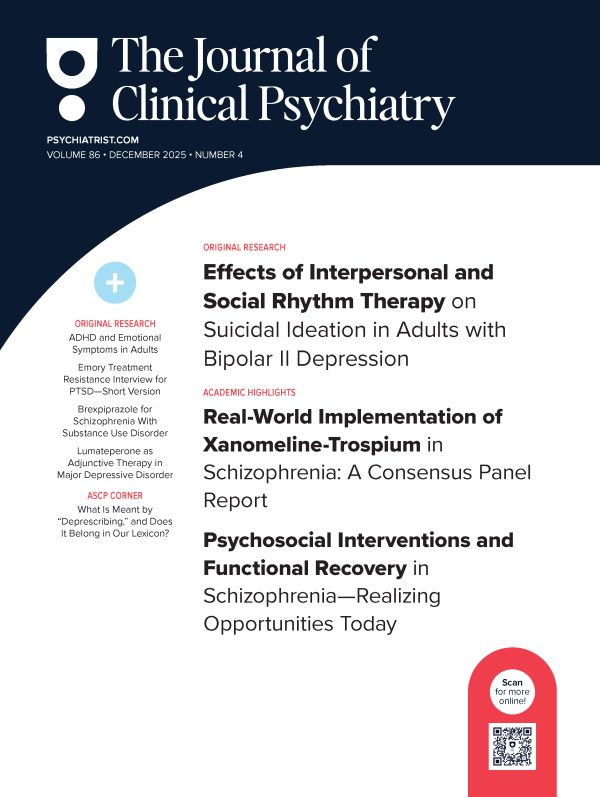More on Mood Disorders in Youth
This month’s Focus on Childhood and Adolescent Mental Health section includes 3 articles addressing important aspects of mood disorders in youth including familiality of bipolar I disorder, effects of comorbidity on the phenomenology of bipolar disorder in youth, and assessment of the validity of disruptive mood dysregulation disorder with dysphoria in youth. A timely publication on how psychosocial factors may affect bariatric surgery outcomes is also included.
Wozniak and colleagues examined the risk for bipolar I disorder in first-degree relatives of children with DSM-IV bipolar I disorder. Two sources of data were included as follows: a meta-analysis of controlled family studies and a family study of children who were diagnosed with bipolar I disorder using structured diagnostic interviews. The meta-analysis revealed that the pooled odds ratio of bipolar I disorder for relatives of children with bipolar I disorder was 6.96. The family study included 239 children with DSM-IV bipolar I disorder, 162 children with attention-deficit/hyperactivity disorder (ADHD) without bipolar I disorder, and 136 healthy control subjects. It was shown that the first-degree relatives of children with bipolar disorder were significantly more likely to have bipolar I disorder compared to the first-degree relatives of ADHD (hazard ratio = 3.02) and control (hazard ratio = 2.83) probands. These findings demonstrate the high familiality of pediatric bipolar disorder, and the authors conclude that their study provides strong support for the validity of pediatric bipolar disorder as a diagnostic entity.
ADHD and anxiety disorders are often comorbid with bipolar disorder in youth. Masi and colleagues examined whether ADHD and multiple anxiety disorders affect the phenomenology of bipolar disorder in youth. The investigators compared youth with bipolar disorder without ADHD or multiple anxiety disorders (n = 52), youth with bipolar disorder plus multiple anxiety disorders without ADHD (n = 76), and youth with bipolar disorder plus ADHD without anxiety disorders (n = 49). These youth were assessed with a semistructured clinical interview and followed up for at least 6 months. The occurrence of ADHD prior to bipolar disorder significantly impacted the presentation and the course of bipolar illness. Compared to youth with bipolar disorder with and without anxiety disorders, those youth who had bipolar disorder plus ADHD were younger; had an earlier age at onset of illness, a more chronic course, and more functional impairment; and were more treatment resistant. The authors suggest that bipolar disorder with ADHD may be a distinct early onset type of bipolar disorder. They recommend future studies aimed at early treatment of ADHD to possibly prevent a severe course of bipolar illness in youth.
The proposed diagnosis disruptive mood dysregulation disorder (DMDD) in the DSM-5 has led to considerable controversy regarding the validity of DMDD as a distinct diagnosis in youth. DMDD is characterized by severe recurrent temper outbursts and irritable or angry mood between temper outbursts that have persisted for at least a year. Axelson and colleagues evaluated the validity of the DMDD diagnosis by examining the clinical phenomenology of 706 children who participated in the Longitudinal Assessment of Manic Symptoms (LAMS) study. At intake, 26% of LAMS participants met a retrospective diagnosis of DMDD. The sample was assessed at 12-month and 24-month follow-up. Compared to youth without DMDD, youth with DMDD had higher rates of oppositional defiant disorder and conduct disorder but not mood disorders, anxiety disorders, or ADHD. Similarly, the majority of youth with oppositional defiant disorder and conduct disorder met DMDD criteria compared to those youth without DMDD. The investigators conclude that DMDD is not a distinct disorder since it could not be readily differentiated from disruptive behavior disorders and it did not have a distinct course or outcome compared to non-DMDD disorders. The authors recommend that further research be conducted to determine whether DMDD is a valid diagnostic category in youth.
This month’s section also includes a study of the effects of bariatric surgery for the treatment of obese adolescents. Sysko and colleagues assessed 101 severely obese adolescents who received laparoscopic adjustable gastric banding (LAGB). Beck Depression Inventory and Pediatric Quality of Life Inventory scores were obtained presurgery and postsurgery (1, 3, 6, 9, 12, and 15 months following LAGB). Both depressive symptoms and quality of life significantly improved following LAGB. Two presurgical factors were found to be significant predictors of weight change postsurgery. Family conflict and loss of control eating (consumption of a large amount of food while experiencing loss of control) were associated with higher body mass index post-LAGB. The authors stress the importance of examining other presurgical and postsurgical psychosocial factors that may affect LAGB outcomes in youth.
J Clin Psychiatry 2012;73(10):1326-1327 (doi:10.4088/JCP.12f08132)
© Copyright 2012 Physicians Postgraduate Press, Inc.



